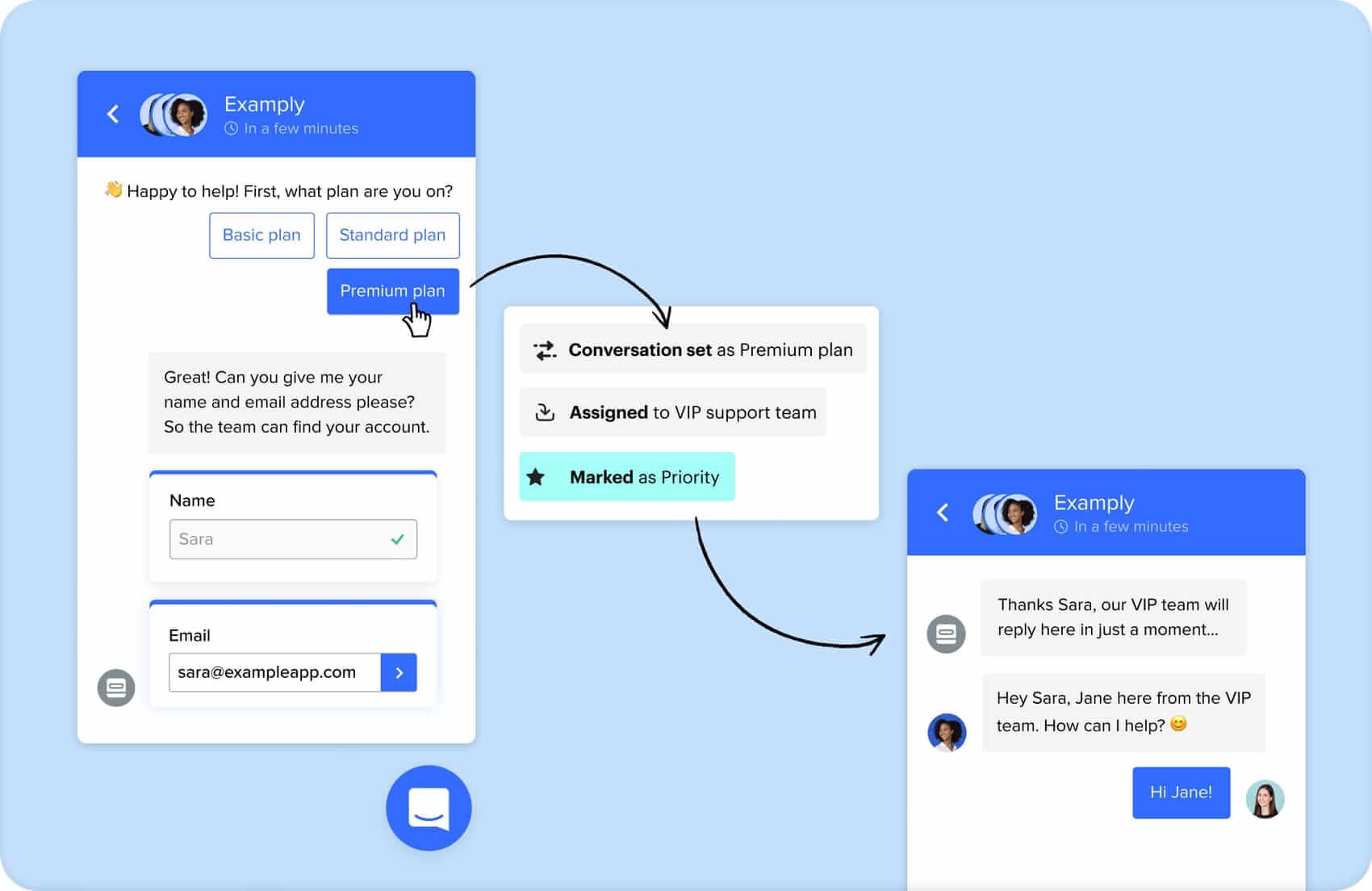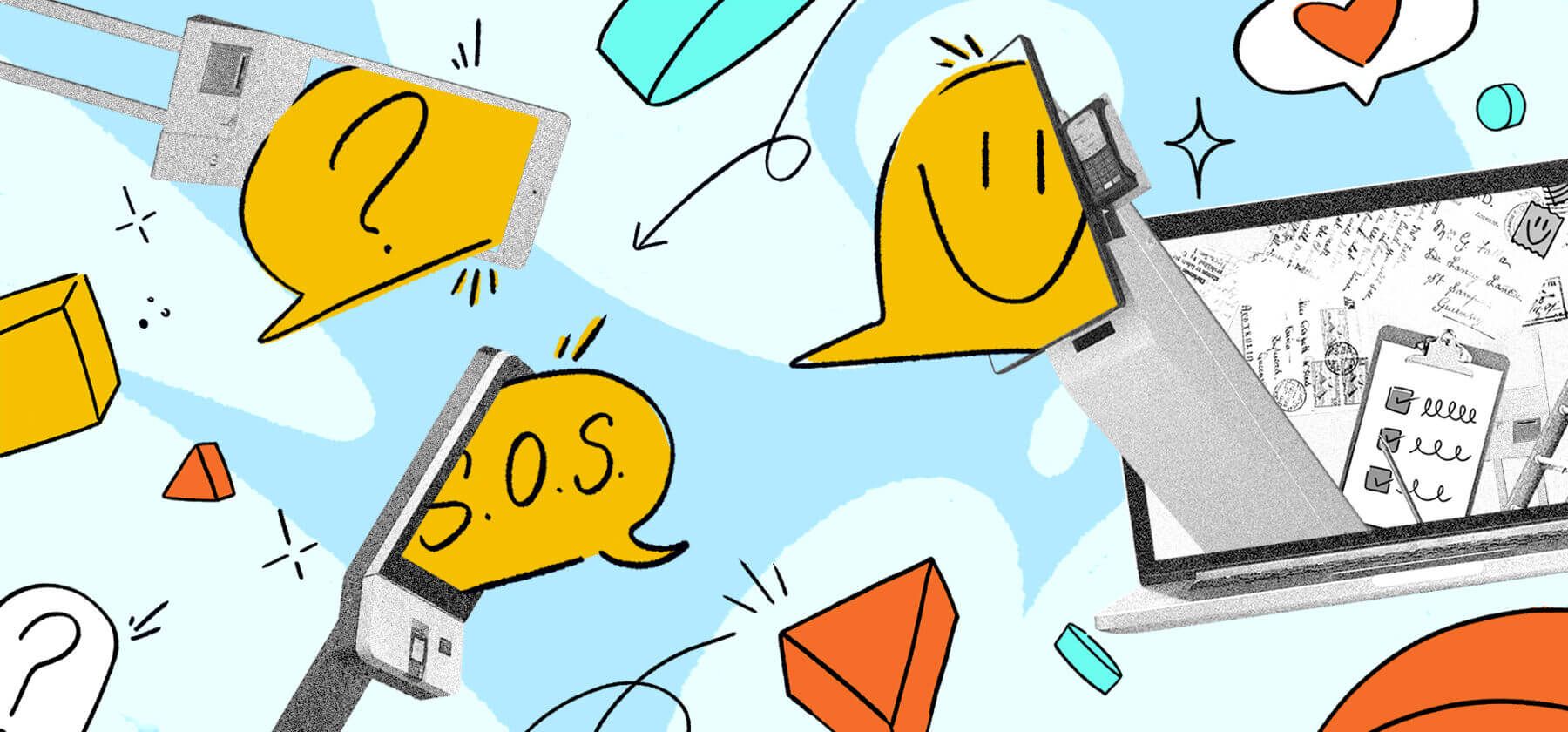
The support leader’s guide to scaling smarter with self-serve support
Some 80% of customers are more likely to do business with a company that offers a personal experience. But as your company grows, how do you offer personalized support at scale without burning out your team or budget? Modern self-serve support is key to scaling smarter.
“How do I update my password?” “What’s your cancellation policy?” Answering simple, repetitive questions like these can feel like Groundhog Day for your team. Not only is this time-consuming, it’s also a heavy drain on your support team’s resources and morale. No one wins when your team is stuck running up an endless ticketing treadmill – especially not your customers!
Keeping pace with a constant flow of support tickets means all of your customers will have to wait longer for a response. Plus, study after study reveals that many customers would rather self-serve than talk to a support rep at all.
Modern customers are used to living in an on-demand world where their every whim can be met 24/7 – think online shopping, instant news updates, and personalized Netflix feeds. Self-serve support satisfies customers’ need for speed, control, and personalization. With contextual help content and bots you can provide customers with on-demand answers to simple questions, like: “Where can I update my billing details?” and “What’s your typical US delivery timeframe?”
Ultimately, self-serve support empowers you to scale your support and provide customers with the fast answers they need, when they need them – without upping your headcount or overstretching your team. Below, we share the latest and greatest self-serve support strategies – including how to resolve repetitive queries with contextual help content and targeted bots, measure and optimize your self-serve strategy, and ultimately, position support as a core value driver for your business.
Let self-serve support handle the simple, repetitive queries
At Intercom, we use a framework called the Support Funnel to deliver efficient, personal support to our customers at scale. It combines proactive, self-serve, and human support capabilities to get ahead of known problems before they arise, automatically answer repetitive queries, and quickly resolve complex issues.
With the funnel, self-serve and proactive support resolve most simple, repetitive queries, meaning only the most complex, critical issues ever reach your team.

Armed with the right self-serve support strategy and tools, you can empower customers to help themselves at pivotal moments in their customer journey, like when they’re onboarding or getting up to speed with a new product or feature. You can (and should) also use self-serve support as an opportunity to educate your customers on how to get the most value from your product or service.
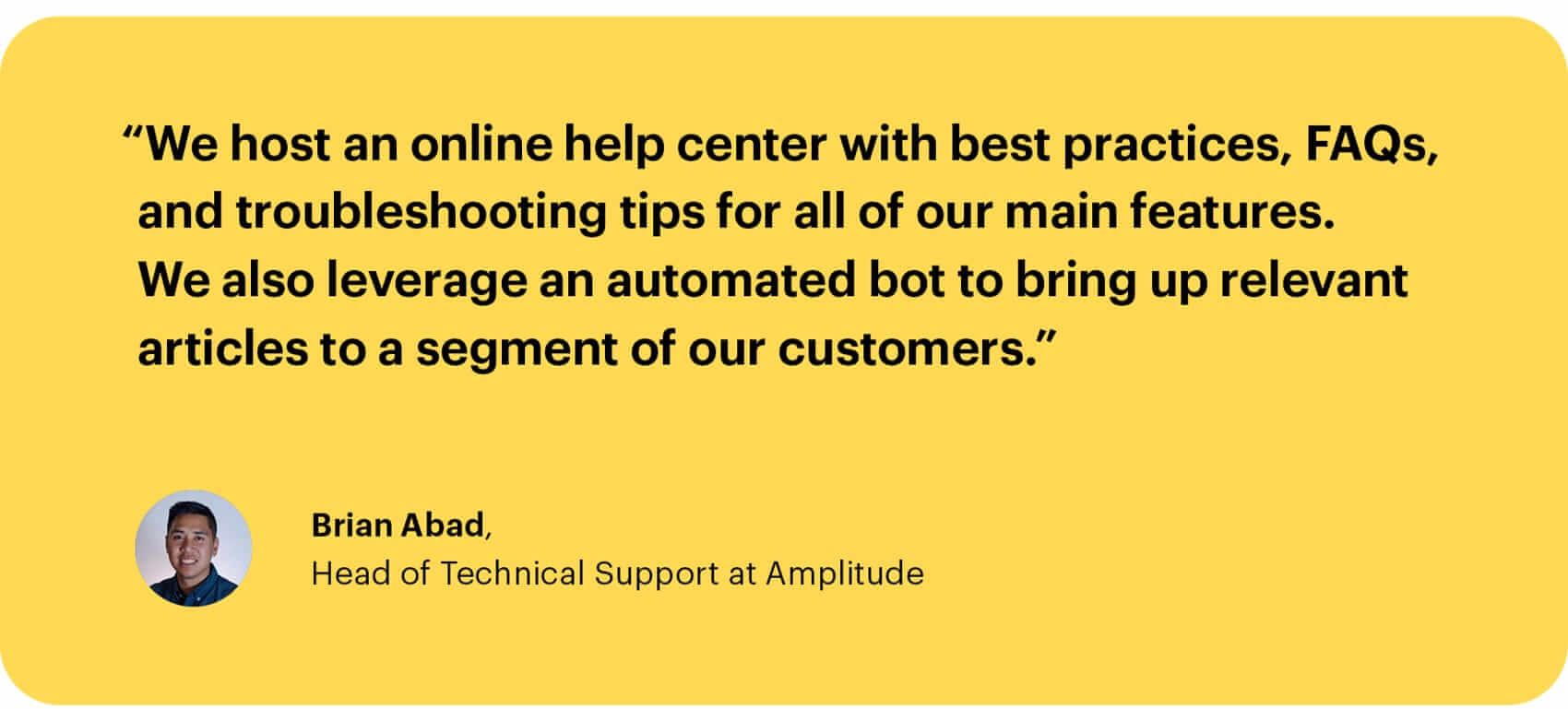
By embracing the funnel, you’ll drastically reduce the number of simple, repetitive queries that reach your support team, all while keeping your customers satisfied. And when most of your customers’ questions are resolved through self-serve support, it frees up your team to focus on your most important, complex, and VIP support queries.
“50% of support leaders plan to invest more in automation, including chatbots, in the coming year”
Not only will you take pressure off your team, you can also demonstrate how support is impacting your business’ bottom line with positive customer loyalty and retention figures. With all of these powerful benefits, it’s perhaps no surprise that 50% of support leaders plan to invest more in automation, including chatbots, in the coming year to increase the efficiency of their support team.
Create contextual help content that delivers real value
Great help content compounds in value over time. The help content your team creates today will lay the foundations for supporting thousands, maybe even millions, of your customers for years to come. Not only will it empower your customers to self-serve, it can also provide them with proactive guidance from day one of using your product or service.
“With modern customer support tools, you can deliver help in context to the right customers, at the right time”
It’s worth taking the time to get this right, so you can offer more help to a greater number of customers and significantly reduce your overall conversation volume in the process. Here are our tips for creating content that delivers long-term value:
1. Map your help content to your customers’ journey
With traditional knowledge bases, the key question is often: “How can we create articles that satisfy our customers’ search intent?” That’s still a worthy pursuit; however, with modern customer support tools, you can take your content one step further and deliver help in context to the right customers, at the right time.
So the question then becomes, “How can we meet customers wherever they are?” – whether that’s in your product, or browsing your website.

We recommend planning out the different types of articles you need to help customers at each stage of their journey. For example:
- Getting started guides are perfect for onboarding customers to new products or features.
- FAQs and how-to articles are great for activating customers and getting them up and running with your product or service.
- Best practice guides and troubleshooting articles are ideal for helping customers get value from your product, empowering them to overcome common hurdles, and ultimately, turning them into long-term, loyal customers.
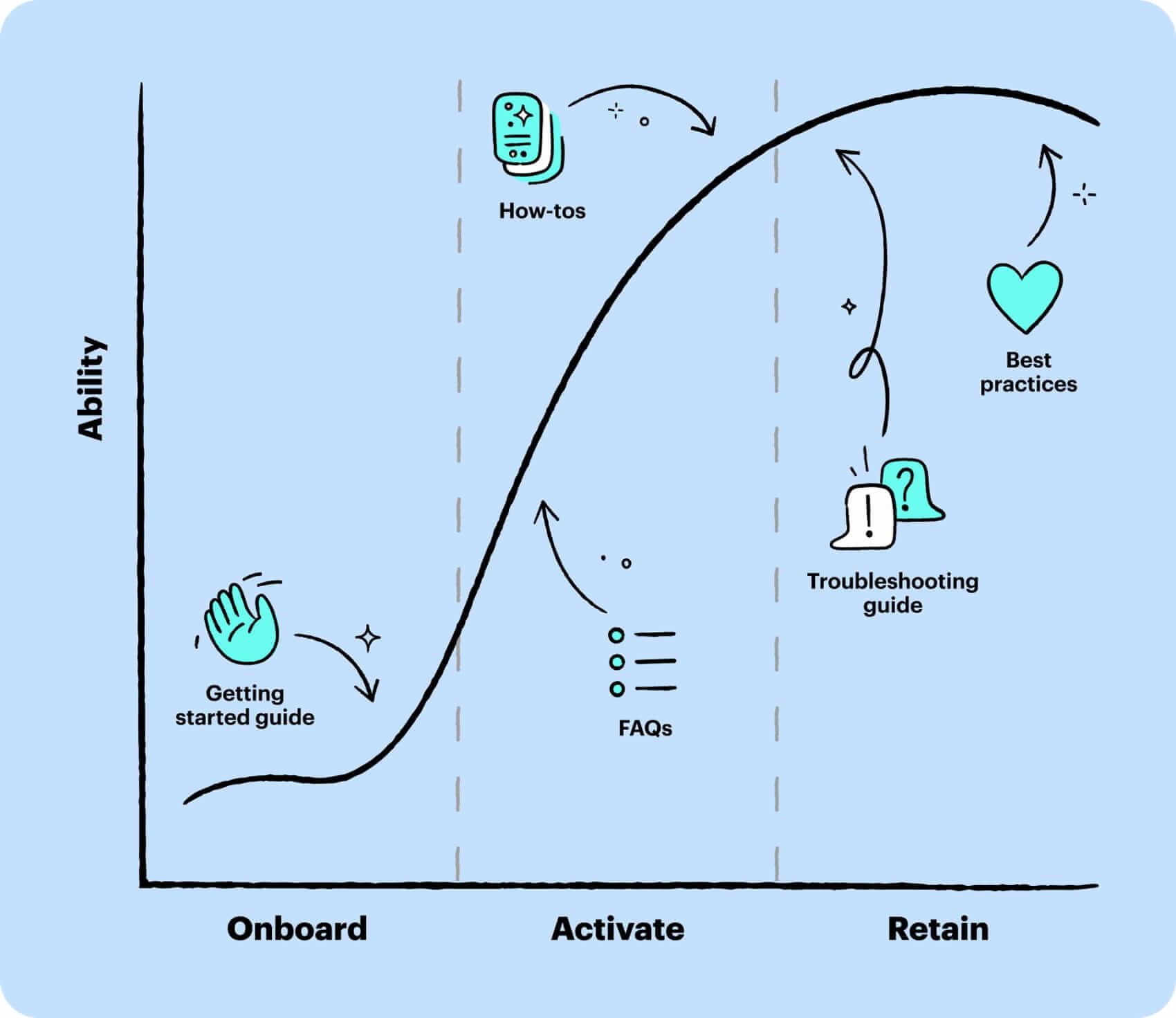
2. Define your funnel vision
At the planning stage, you’ll also want to define where and how you’ll deliver your help content within the Support Funnel. For example, when your customers are starting out with your product or service they’re bound to have lots of questions. We recommend setting up your messenger to act like the receptionist of your product or website. For example, you can set up a relevant FAQ article to appear once a customer opens the messenger, helping guide them towards the help they need.

3. Mirror your customers’ language
People don’t search for your solution, they search for their problem. So if your customers are searching for “Cannot create new project,” you don’t want to be writing articles about “Scaling database errors”. Translating your product’s concepts into customer-friendly language will help you optimize your help content for both search engines and bots.
4. Show as well as tell
Using images, videos, and gifs removes the need for enumerating steps or writing overly wordy descriptions. Why waste your customers’ time with a few paragraphs of text when you can quickly show them what to do? Use tools like Skitch to create screenshots and Droplr for gifs to help your customers quickly comprehend complex ideas.
5. Make your articles easy to scan
Don’t bog your readers down with a wall of text – use subheadings, bulleted lists, and images to break up text, and keep sentences and paragraphs as short as possible. White space is your customers’ friend.
6. Use real-life examples
Almost all the examples we use in our help content are taken directly from our customers. That means actually talking to them and listening to their stories. Then, when a customer runs into trouble, they’ll have real-life examples, not abstract use cases they can’t relate to.
4 self-serve chatbots to supercharge your support
One of the most powerful ways to provide fast, personal help exactly when customers need it is through well-crafted bots. Here are four powerful bots we recommend setting up:
1. FAQ bot
When a customer writes in with a simple question, like “How do I change my credit card details?” they expect a close-to-instant response. You can set up a chatbot to automatically resolve simple, frequent questions – our data shows that chatbots speed up response times by an average of 3X, which significantly boosts customer satisfaction.
“Resolution Bot speeds up self-service by surfacing relevant answers based on what customers are typing”
With Intercom, you can use Resolution Bot to speed up self-service even further by surfacing relevant answers based on what customers are typing – before they even hit the enter key. And you can even have your bot predict answers as soon as customers open the Messenger based on what page they’re on or other contextual cues. It’s our version of the FAQ bot – just supercharged!
Pro tip: The secret to ensuring your FAQ bot delivers razor-accurate answers lies in its training. First, identify the common topics your customers ask about, then create an effective answer for each common question.
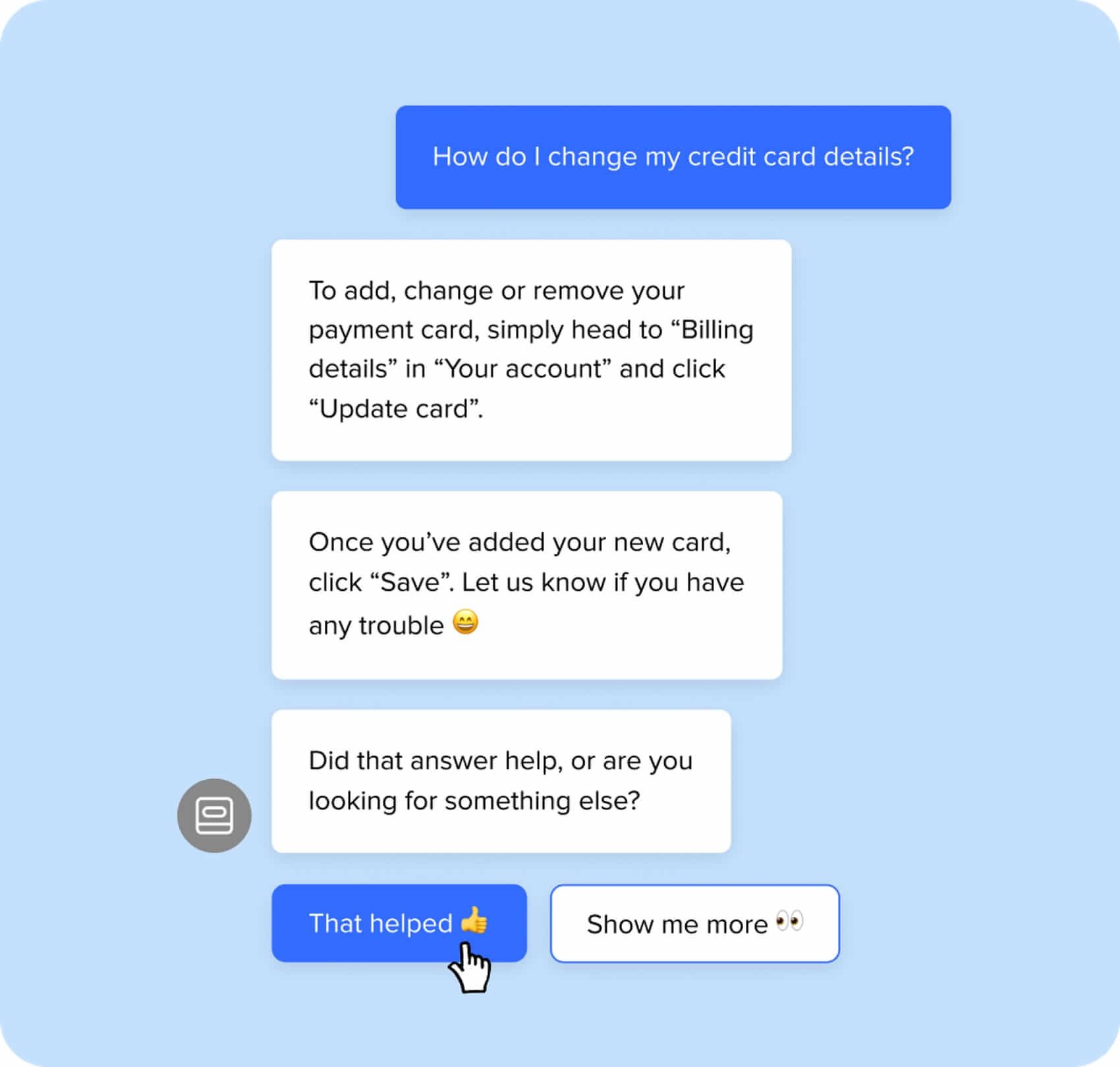
2. Triage bot
Modern customers are busy with a capital B. They don’t have time to type out every detail about an issue in a lengthy email or form. Bots make it easy for customers to input important information in a way that feels lightweight, faster, and more conversational.
“When customers write in with priority queries, they’ll get the right person the first time around, rather than being passed from rep to rep”
For example, you can set up a Triage bot to prompt customers to select key details about the type of issue they have – like if it’s a technical issue or feature request. Then, you can automatically route their issue to the right support team based on what they need and even flag critical issues as priority.
So when customers write in with priority queries, like those related to their billing, they’ll get the right person the first time around, rather than being put on hold or passed from rep to rep.
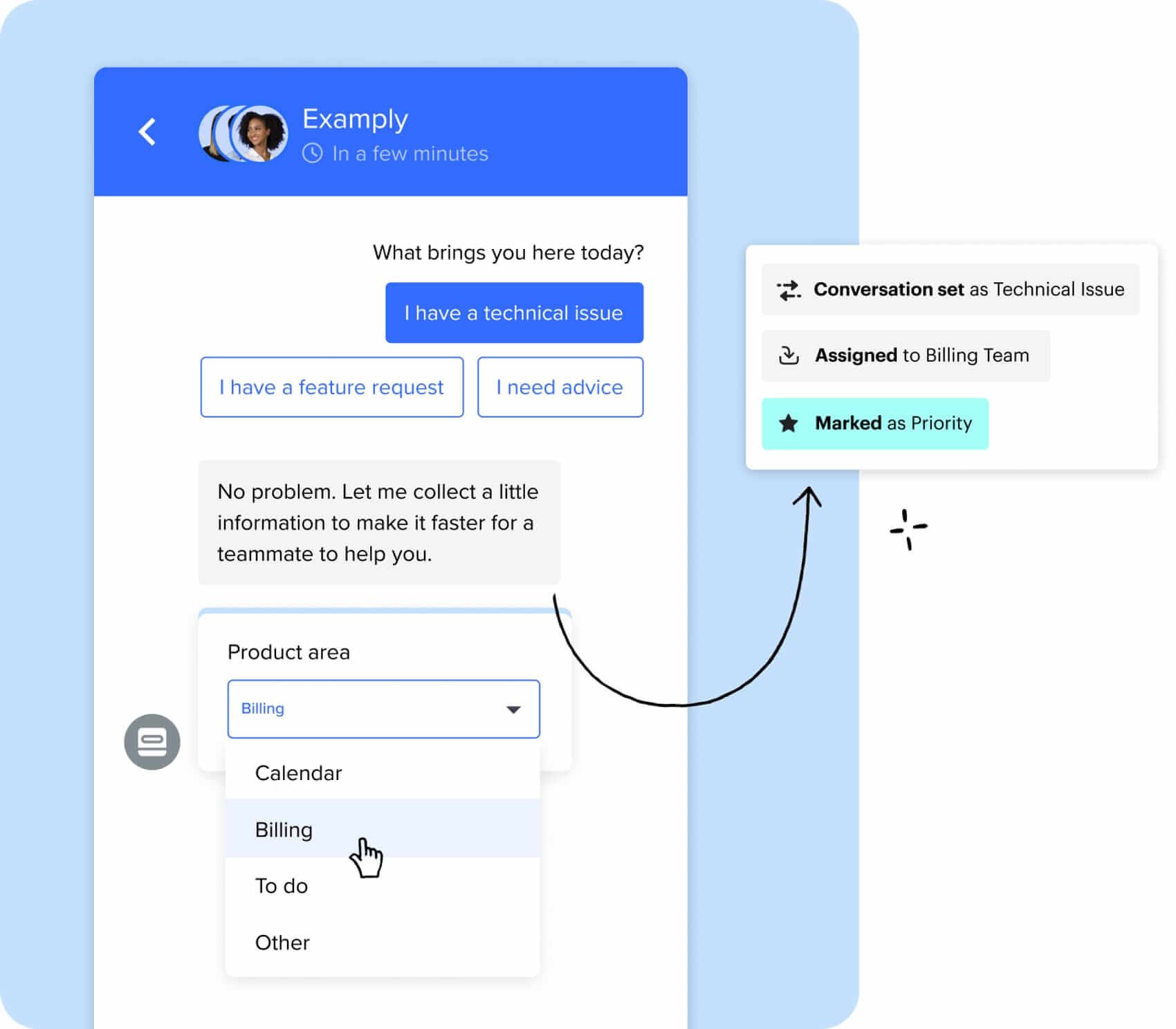
3. Out of Office bot
Long-lasting, quality relationships are built on trust. To lay the foundations of trust with your customers, there are three golden rules to abide by:
- Do what you say you’re going to do.
- Be there when you say you’re going to be there.
- Set expectations when you’re not available.
Whether your team is fast asleep or snorkeling in Aruba (team offsite, anyone?), you can set up an Out of Office bot to set customer expectations 24/7 and let them know when you’ll reply. Your bot can even follow up with helpful next steps, like encouraging customers to check out your FAQs in the meantime.
“Your bot will be there to answer questions when it can and set customer expectations when it can’t”
This also gives your support reps peace of mind – there’s no need to work overtime as your bot will be there to hold the fort, answer questions when it can, and set customer expectations when it can’t.
Pro tip: With Intercom’s Custom Bots, you can offer different follow-up options to customers based on who they are and what they need. For example, you can invite customers on your premium plan to leave a message and prompt your freemium customers to visit your help center.
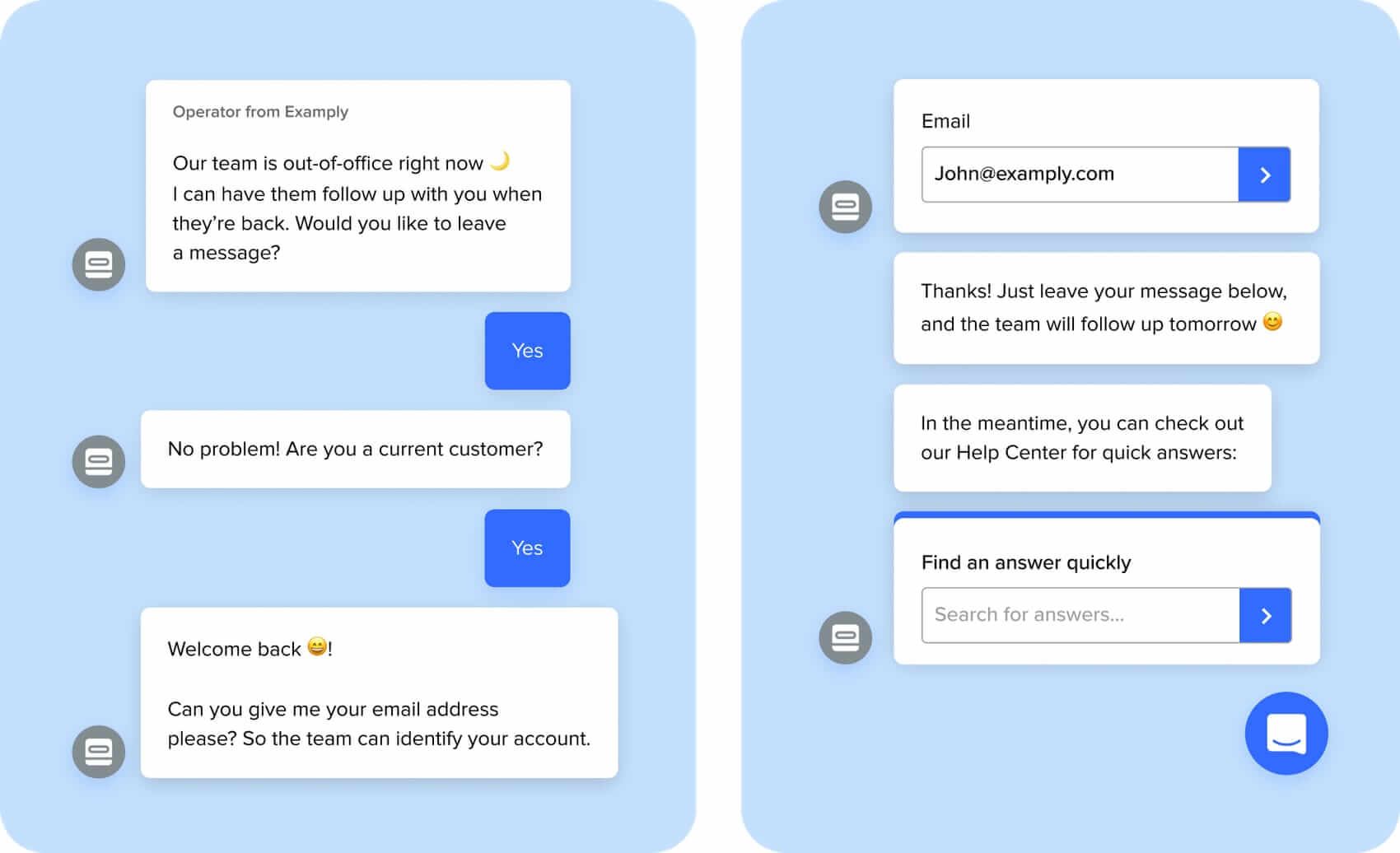
4. VIP Customer bot
Oftentimes, high-value customers, like those on your premium plan, will expect VIP support. Maybe it’s even part of the package they signed up for. Either way, these customers are often larger businesses who have more complex needs and their specific issues may require a deeper investigation with your team. You can set up a VIP bot to quickly identify messages from your highest-spending customers, then escalate their messages to your VIP team, so the right support specialist can step in to reply ASAP.
Pro tip: With Intercom, you can automatically mark VIP messages as Priority ⭐ as well as routing them to your VIP inbox.
Proper botiquette: 6 principles to staying personal
There’s a misconception among support leaders that bots can’t be personal. The truth is that bots can (and should) be deeply personal. That said, there are a few rules that will help you get more bang from your bots and deliver better experiences for your customers. Below, we share our six rules for chatbot etiquette (or “botiquette” for short 😉):
1. Don’t pretend it’s a human
When designing a chatbot, there’s often a strong temptation to give it a name, a face, even a little personality of its own. But if your customer thinks your bot is a person, they’ll expect it to respond like one when it can’t. That doesn’t mean you can’t give your bot a personality or customize it to match your brand. But “Jenny from Examply” shouldn’t be ExamplyBot in disguise.
2. Personalize the experience
Not everyone who asks for help will need that help in the same way. Your chatbot should send customers down different paths based on who they are and what they need. For example, if a customer wants to reset their password your bot can help resolve the issue with a quick answer. If they have a bug to report, on the other hand, your bot can route the issue to the tech arm of your support team to investigate further.

3. Keep it short and simple
Today, in this modern era of automation, the most personal thing you can do is resolve your customer’s question as fast as possible. Chatbot interactions should be short, precise, and to the point. So collect any information you need to make your response personal, but then give customers the help they need and get out of their way.
4. Set clear expectations
No matter what your business looks like, unmet and unclear expectations are the source of all heartache. A good customer experience is rooted in setting crystal clear customer expectations. When a customer writes in, set up your bot to let them know how long they’re going to wait. And if the wait is on the longer side, then make sure to meet that expectation.
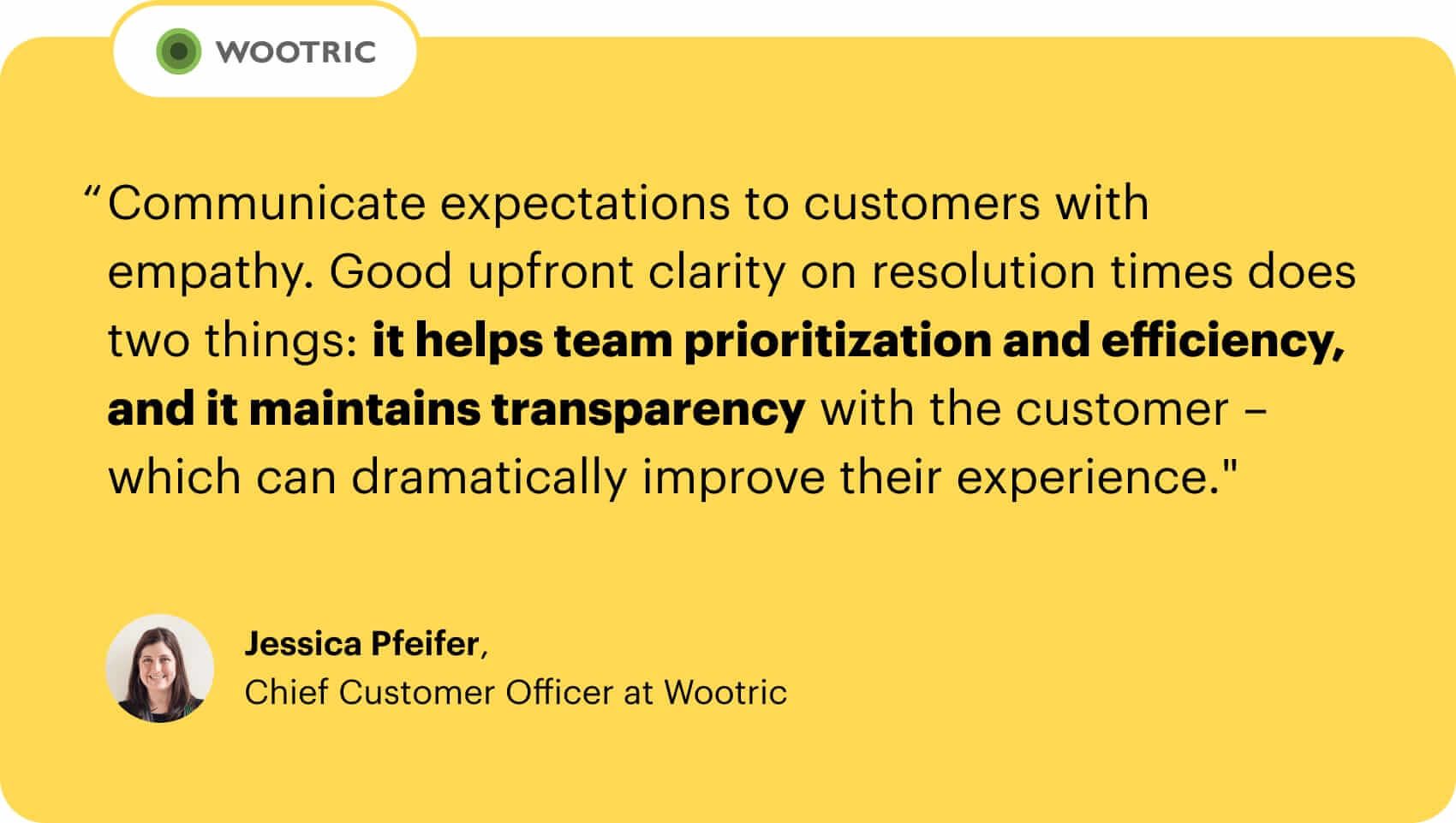
5. Empathy is about anticipating needs, not saying nice things
We strongly believe automated interactions can still be empathetic interactions – but empathy isn’t necessarily what you think. Designing an empathetic chatbot has nothing to do with making the bot say nice things. It has everything to do with understanding your customers’ context and creating bots that accurately anticipate and address their needs.
6. Provide an escape hatch
The last thing you want is for your customers to feel like they’re trapped in the chatbot equivalent of a phone tree. “Press 9 to hear these options again” is a far worse experience than letting them disengage from your bot entirely and providing clear next steps for how to find help. If your customer has engaged with a bot, and it’s not going well for them, there should be an easy way out – whether that’s:
- Letting them chat directly with your team.
- Giving them clear next steps, like encouraging them to check out a list of your most popular FAQs.
Metrics for championing and optimizing self-serve support
Peter Drucker said it best: “If you can’t measure it, you can’t improve it.” The same goes for your self-serve support strategy. While there are infinite metrics you could track and tweaks you can make, it’s important to identify what business outcomes you’re trying to solve for, up front, with your self-serve support. That will help you ensure you’re making and measuring the most impactful wins for your team. Here are our tips:
Track efficiency metrics
Once you’ve implemented the funnel, you’ll want to measure and monitor any major efficiency gains your self-serve support influences over time. We recommend setting a benchmark you can track progress towards for key self-serve support metrics like:
- Rate of Automated Resolution (ROAR). By adopting a strategic self-serve support approach at Intercom we’re currently hovering at around a 4.5% Rate of Automated Resolution (ROAR), which means 4.5% of all customer issues are resolved without a human being involved. This translates to about $400,000 saved per year.
- Conversations closed by articles. At Intercom, if someone reads one of our help center articles they’ll be prompted to let us know whether it answered their question. If they indicate the question is resolved by giving it a thumbs up we’ll track that as part of our “conversations closed by articles” rate.
Set bottom-line metrics that move the needle
Self-serve support helps you elevate the support function within your company, so your team can go from drowning in reactive conversations (the old way) to carving out more time to become strategic, revenue-generating business partners (the new conversational way).
“To position support as a value driver, get buy-in from key teams, like marketing and sales”
One of the best ways to position support as a value driver is to get buy-in from key teams, like marketing and sales, and to co-own bottom-line metrics together such as:
- Customer loyalty
- Customer retention
- Customer renewals
Optimize your bots and help content to work harder
Once your help content and bots are live, don’t let them go stale or become irrelevant. You’ll want each message and piece of content to work as hard as it can for your customers and your business.
Success starts with asking meaningful, pointed questions. For example:
- What questions are customers most often searching for or frequently writing in with, but can’t find? Go ahead and create relevant help content using the exact words your customers typed.
- How are your bots performing? Are they engaging customers and resolving issues effectively? If there’s an answer or message that’s underperforming, try tweaking the copy or filters to improve performance.
- How is your help content performing? Which articles are closing the most conversations? High-performing articles are worth investing more in, while you should consider gutting or reworking low traffic articles.
Get the full strategy for delivering fast, personal support at scale
Self-serve support empowers you to scale your support and provide customers with the answers they need, when they need them. But it’s only one piece of the puzzle for delivering fast, personal support to your customers at the scale your business needs. Get The Ultimate Guide to Conversational Support to learn how to combine proactive, self-serve and human support to achieve world-class support – without burning out your team or budget.
Better customer relationships and a more efficient, cost-effective support machine await👇

